HR Strategy and Employment Relations at John Lewis Partnership
VerifiedAdded on 2021/02/21
|11
|3733
|134
Report
AI Summary
This report provides a comprehensive analysis of the human resource strategy and employment relations at the John Lewis Partnership. It begins by exploring the relationship between business strategy and HR strategy, emphasizing the importance of vertical alignment and horizontal integration. The report then evaluates various strategic HRM models, including best fit, best practice, and resource-based view, and assesses their application within the company. A significant portion is dedicated to evaluating HR practices related to performance management and reward systems, identifying their strengths and weaknesses. Furthermore, the report delves into the nature and theoretical perspectives of employment relations, examining the roles of different actors and the impact of changing employment dynamics. It concludes with recommendations on how mechanisms like employee participation and employee voice can improve employment relations within the organization, offering valuable insights for strategic HR management.
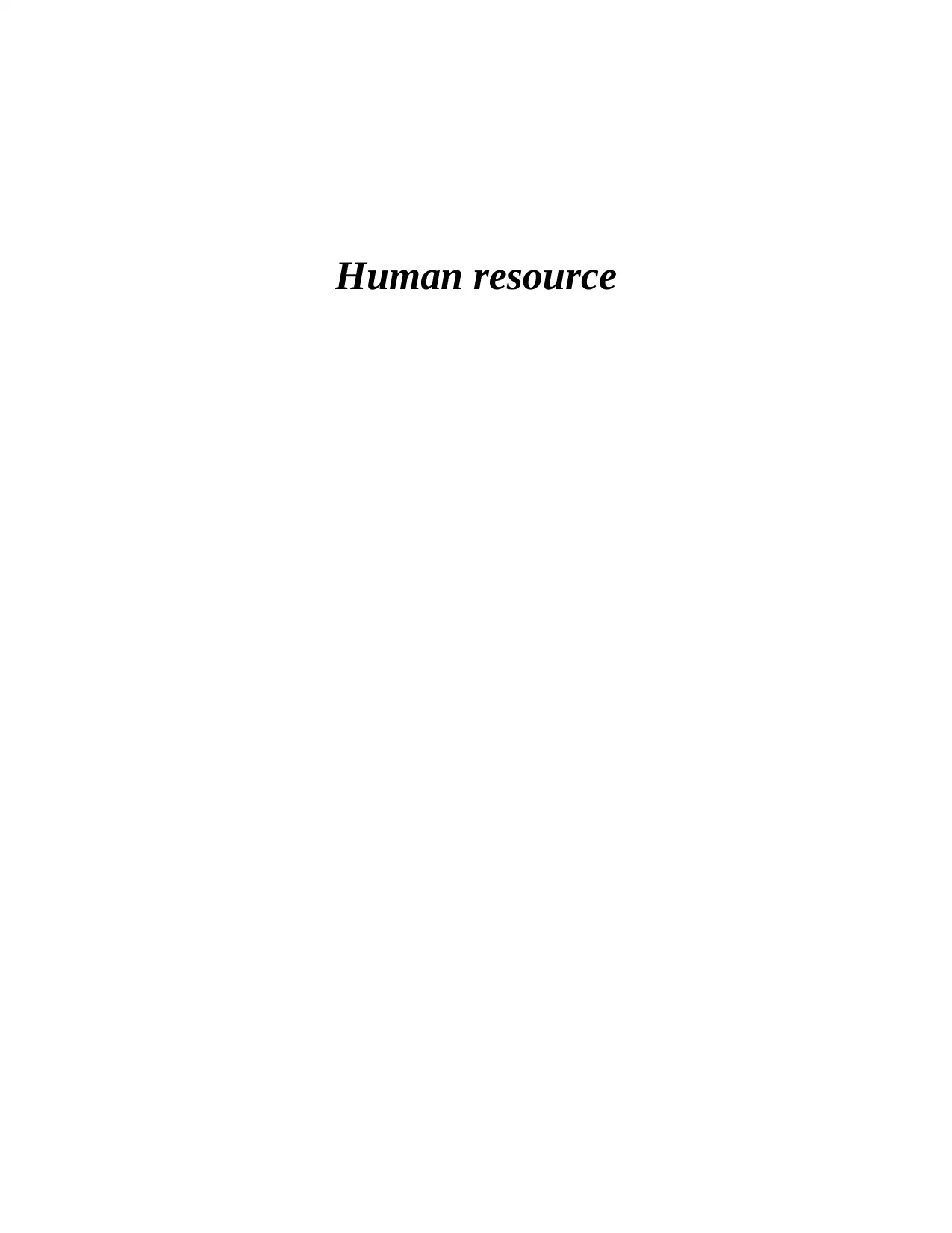
Human resource
Paraphrase This Document
Need a fresh take? Get an instant paraphrase of this document with our AI Paraphraser
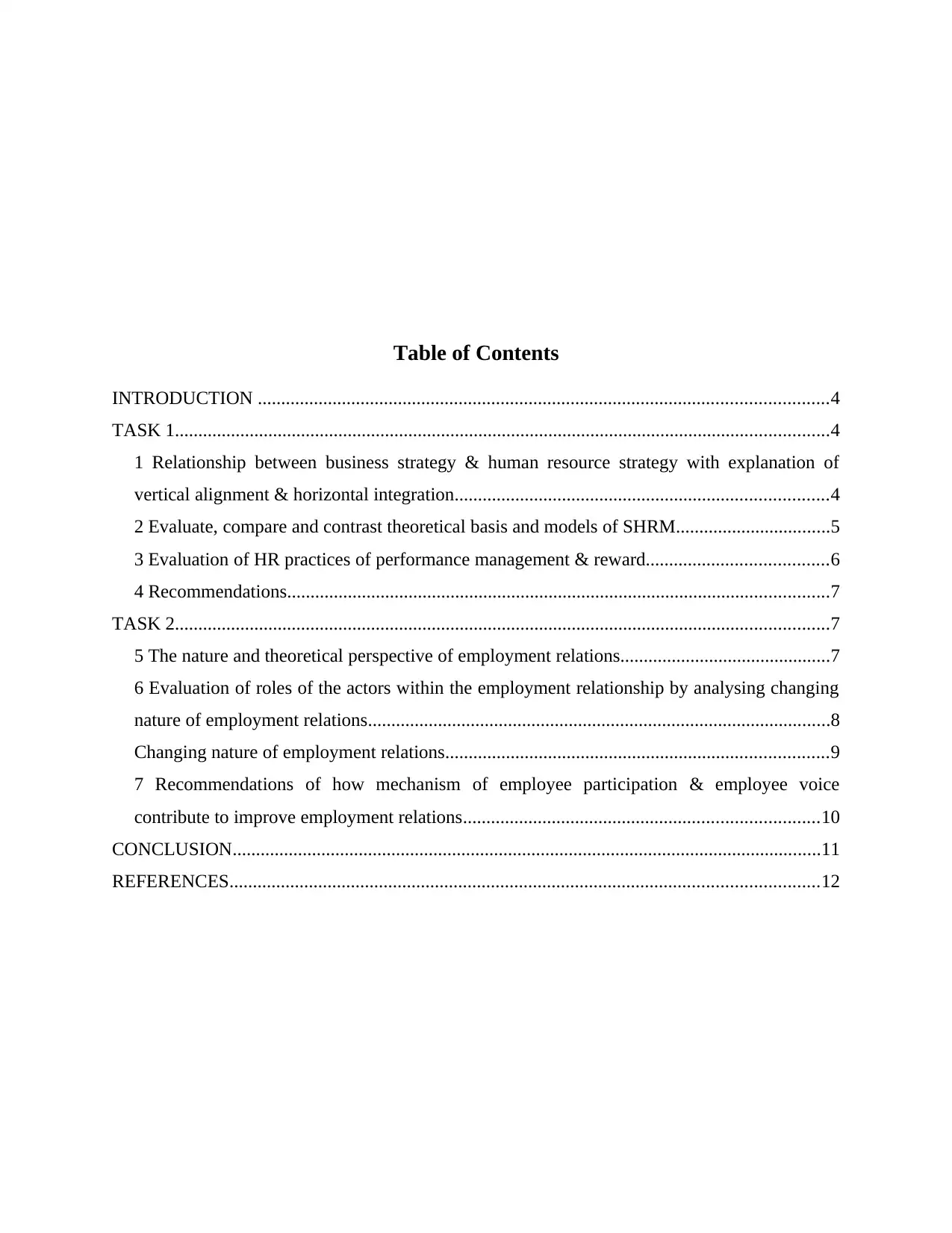
Table of Contents
INTRODUCTION ..........................................................................................................................4
TASK 1............................................................................................................................................4
1 Relationship between business strategy & human resource strategy with explanation of
vertical alignment & horizontal integration................................................................................4
2 Evaluate, compare and contrast theoretical basis and models of SHRM.................................5
3 Evaluation of HR practices of performance management & reward.......................................6
4 Recommendations....................................................................................................................7
TASK 2............................................................................................................................................7
5 The nature and theoretical perspective of employment relations.............................................7
6 Evaluation of roles of the actors within the employment relationship by analysing changing
nature of employment relations...................................................................................................8
Changing nature of employment relations..................................................................................9
7 Recommendations of how mechanism of employee participation & employee voice
contribute to improve employment relations............................................................................10
CONCLUSION..............................................................................................................................11
REFERENCES..............................................................................................................................12
INTRODUCTION ..........................................................................................................................4
TASK 1............................................................................................................................................4
1 Relationship between business strategy & human resource strategy with explanation of
vertical alignment & horizontal integration................................................................................4
2 Evaluate, compare and contrast theoretical basis and models of SHRM.................................5
3 Evaluation of HR practices of performance management & reward.......................................6
4 Recommendations....................................................................................................................7
TASK 2............................................................................................................................................7
5 The nature and theoretical perspective of employment relations.............................................7
6 Evaluation of roles of the actors within the employment relationship by analysing changing
nature of employment relations...................................................................................................8
Changing nature of employment relations..................................................................................9
7 Recommendations of how mechanism of employee participation & employee voice
contribute to improve employment relations............................................................................10
CONCLUSION..............................................................................................................................11
REFERENCES..............................................................................................................................12
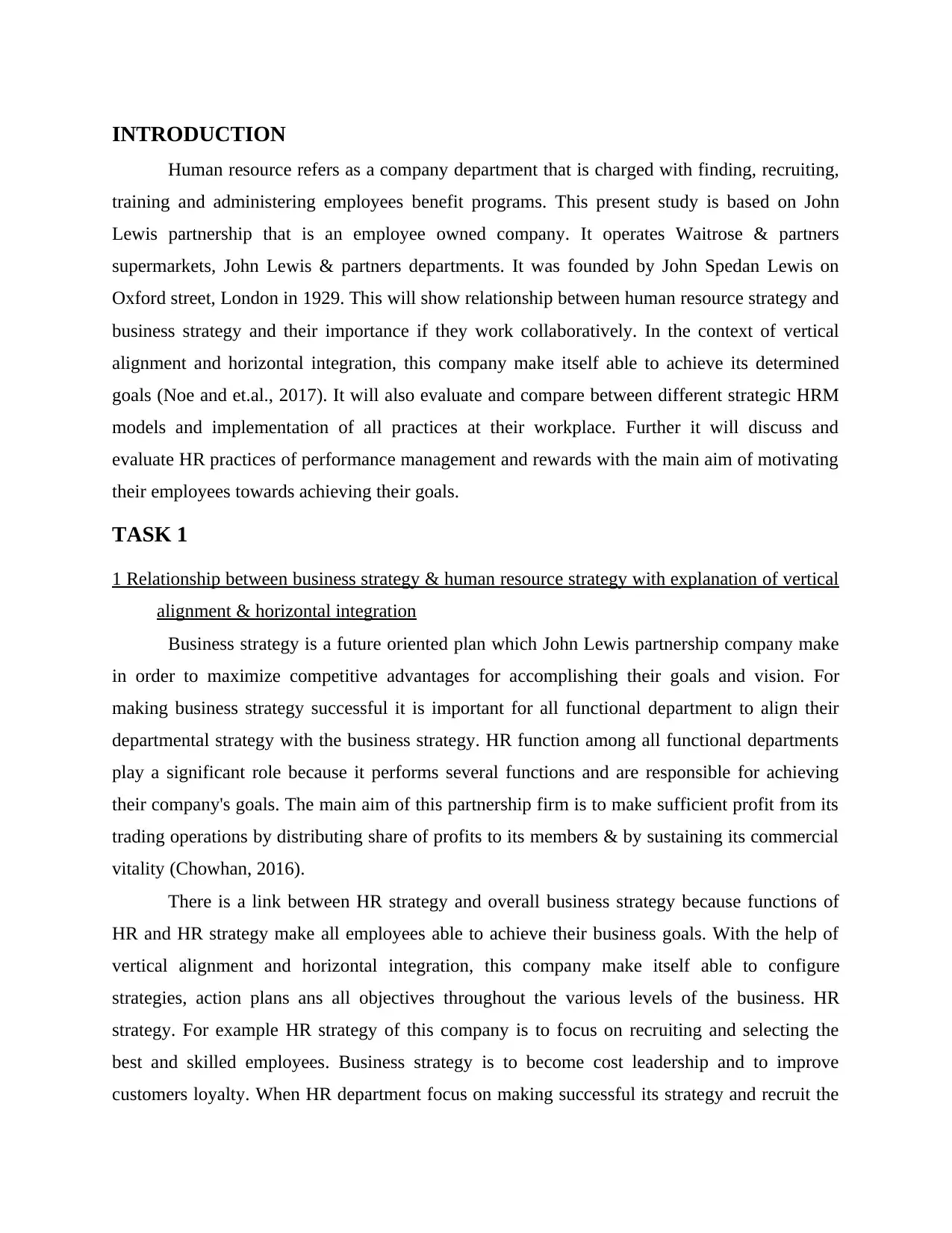
INTRODUCTION
Human resource refers as a company department that is charged with finding, recruiting,
training and administering employees benefit programs. This present study is based on John
Lewis partnership that is an employee owned company. It operates Waitrose & partners
supermarkets, John Lewis & partners departments. It was founded by John Spedan Lewis on
Oxford street, London in 1929. This will show relationship between human resource strategy and
business strategy and their importance if they work collaboratively. In the context of vertical
alignment and horizontal integration, this company make itself able to achieve its determined
goals (Noe and et.al., 2017). It will also evaluate and compare between different strategic HRM
models and implementation of all practices at their workplace. Further it will discuss and
evaluate HR practices of performance management and rewards with the main aim of motivating
their employees towards achieving their goals.
TASK 1
1 Relationship between business strategy & human resource strategy with explanation of vertical
alignment & horizontal integration
Business strategy is a future oriented plan which John Lewis partnership company make
in order to maximize competitive advantages for accomplishing their goals and vision. For
making business strategy successful it is important for all functional department to align their
departmental strategy with the business strategy. HR function among all functional departments
play a significant role because it performs several functions and are responsible for achieving
their company's goals. The main aim of this partnership firm is to make sufficient profit from its
trading operations by distributing share of profits to its members & by sustaining its commercial
vitality (Chowhan, 2016).
There is a link between HR strategy and overall business strategy because functions of
HR and HR strategy make all employees able to achieve their business goals. With the help of
vertical alignment and horizontal integration, this company make itself able to configure
strategies, action plans ans all objectives throughout the various levels of the business. HR
strategy. For example HR strategy of this company is to focus on recruiting and selecting the
best and skilled employees. Business strategy is to become cost leadership and to improve
customers loyalty. When HR department focus on making successful its strategy and recruit the
Human resource refers as a company department that is charged with finding, recruiting,
training and administering employees benefit programs. This present study is based on John
Lewis partnership that is an employee owned company. It operates Waitrose & partners
supermarkets, John Lewis & partners departments. It was founded by John Spedan Lewis on
Oxford street, London in 1929. This will show relationship between human resource strategy and
business strategy and their importance if they work collaboratively. In the context of vertical
alignment and horizontal integration, this company make itself able to achieve its determined
goals (Noe and et.al., 2017). It will also evaluate and compare between different strategic HRM
models and implementation of all practices at their workplace. Further it will discuss and
evaluate HR practices of performance management and rewards with the main aim of motivating
their employees towards achieving their goals.
TASK 1
1 Relationship between business strategy & human resource strategy with explanation of vertical
alignment & horizontal integration
Business strategy is a future oriented plan which John Lewis partnership company make
in order to maximize competitive advantages for accomplishing their goals and vision. For
making business strategy successful it is important for all functional department to align their
departmental strategy with the business strategy. HR function among all functional departments
play a significant role because it performs several functions and are responsible for achieving
their company's goals. The main aim of this partnership firm is to make sufficient profit from its
trading operations by distributing share of profits to its members & by sustaining its commercial
vitality (Chowhan, 2016).
There is a link between HR strategy and overall business strategy because functions of
HR and HR strategy make all employees able to achieve their business goals. With the help of
vertical alignment and horizontal integration, this company make itself able to configure
strategies, action plans ans all objectives throughout the various levels of the business. HR
strategy. For example HR strategy of this company is to focus on recruiting and selecting the
best and skilled employees. Business strategy is to become cost leadership and to improve
customers loyalty. When HR department focus on making successful its strategy and recruit the
⊘ This is a preview!⊘
Do you want full access?
Subscribe today to unlock all pages.

Trusted by 1+ million students worldwide
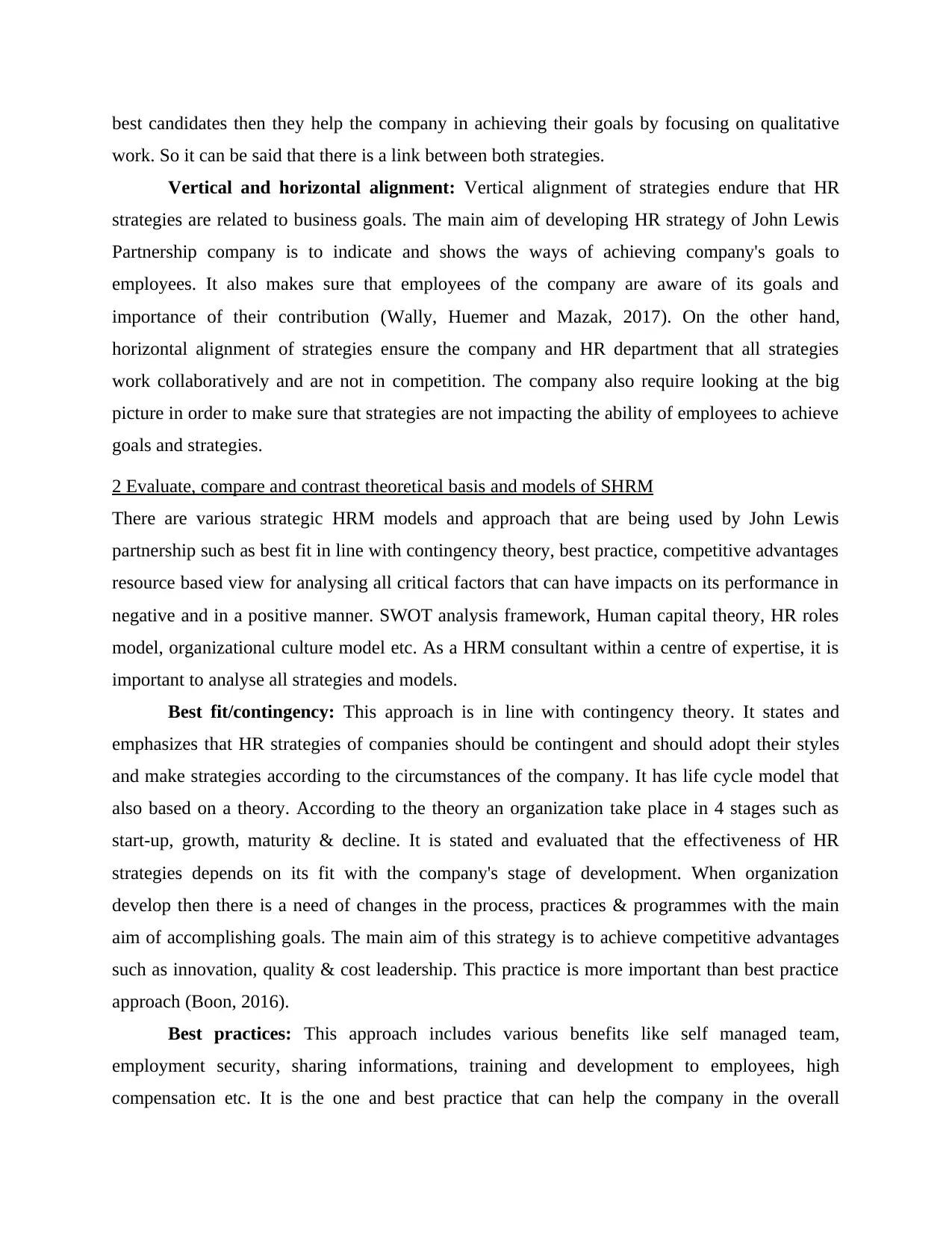
best candidates then they help the company in achieving their goals by focusing on qualitative
work. So it can be said that there is a link between both strategies.
Vertical and horizontal alignment: Vertical alignment of strategies endure that HR
strategies are related to business goals. The main aim of developing HR strategy of John Lewis
Partnership company is to indicate and shows the ways of achieving company's goals to
employees. It also makes sure that employees of the company are aware of its goals and
importance of their contribution (Wally, Huemer and Mazak, 2017). On the other hand,
horizontal alignment of strategies ensure the company and HR department that all strategies
work collaboratively and are not in competition. The company also require looking at the big
picture in order to make sure that strategies are not impacting the ability of employees to achieve
goals and strategies.
2 Evaluate, compare and contrast theoretical basis and models of SHRM
There are various strategic HRM models and approach that are being used by John Lewis
partnership such as best fit in line with contingency theory, best practice, competitive advantages
resource based view for analysing all critical factors that can have impacts on its performance in
negative and in a positive manner. SWOT analysis framework, Human capital theory, HR roles
model, organizational culture model etc. As a HRM consultant within a centre of expertise, it is
important to analyse all strategies and models.
Best fit/contingency: This approach is in line with contingency theory. It states and
emphasizes that HR strategies of companies should be contingent and should adopt their styles
and make strategies according to the circumstances of the company. It has life cycle model that
also based on a theory. According to the theory an organization take place in 4 stages such as
start-up, growth, maturity & decline. It is stated and evaluated that the effectiveness of HR
strategies depends on its fit with the company's stage of development. When organization
develop then there is a need of changes in the process, practices & programmes with the main
aim of accomplishing goals. The main aim of this strategy is to achieve competitive advantages
such as innovation, quality & cost leadership. This practice is more important than best practice
approach (Boon, 2016).
Best practices: This approach includes various benefits like self managed team,
employment security, sharing informations, training and development to employees, high
compensation etc. It is the one and best practice that can help the company in the overall
work. So it can be said that there is a link between both strategies.
Vertical and horizontal alignment: Vertical alignment of strategies endure that HR
strategies are related to business goals. The main aim of developing HR strategy of John Lewis
Partnership company is to indicate and shows the ways of achieving company's goals to
employees. It also makes sure that employees of the company are aware of its goals and
importance of their contribution (Wally, Huemer and Mazak, 2017). On the other hand,
horizontal alignment of strategies ensure the company and HR department that all strategies
work collaboratively and are not in competition. The company also require looking at the big
picture in order to make sure that strategies are not impacting the ability of employees to achieve
goals and strategies.
2 Evaluate, compare and contrast theoretical basis and models of SHRM
There are various strategic HRM models and approach that are being used by John Lewis
partnership such as best fit in line with contingency theory, best practice, competitive advantages
resource based view for analysing all critical factors that can have impacts on its performance in
negative and in a positive manner. SWOT analysis framework, Human capital theory, HR roles
model, organizational culture model etc. As a HRM consultant within a centre of expertise, it is
important to analyse all strategies and models.
Best fit/contingency: This approach is in line with contingency theory. It states and
emphasizes that HR strategies of companies should be contingent and should adopt their styles
and make strategies according to the circumstances of the company. It has life cycle model that
also based on a theory. According to the theory an organization take place in 4 stages such as
start-up, growth, maturity & decline. It is stated and evaluated that the effectiveness of HR
strategies depends on its fit with the company's stage of development. When organization
develop then there is a need of changes in the process, practices & programmes with the main
aim of accomplishing goals. The main aim of this strategy is to achieve competitive advantages
such as innovation, quality & cost leadership. This practice is more important than best practice
approach (Boon, 2016).
Best practices: This approach includes various benefits like self managed team,
employment security, sharing informations, training and development to employees, high
compensation etc. It is the one and best practice that can help the company in the overall
Paraphrase This Document
Need a fresh take? Get an instant paraphrase of this document with our AI Paraphraser
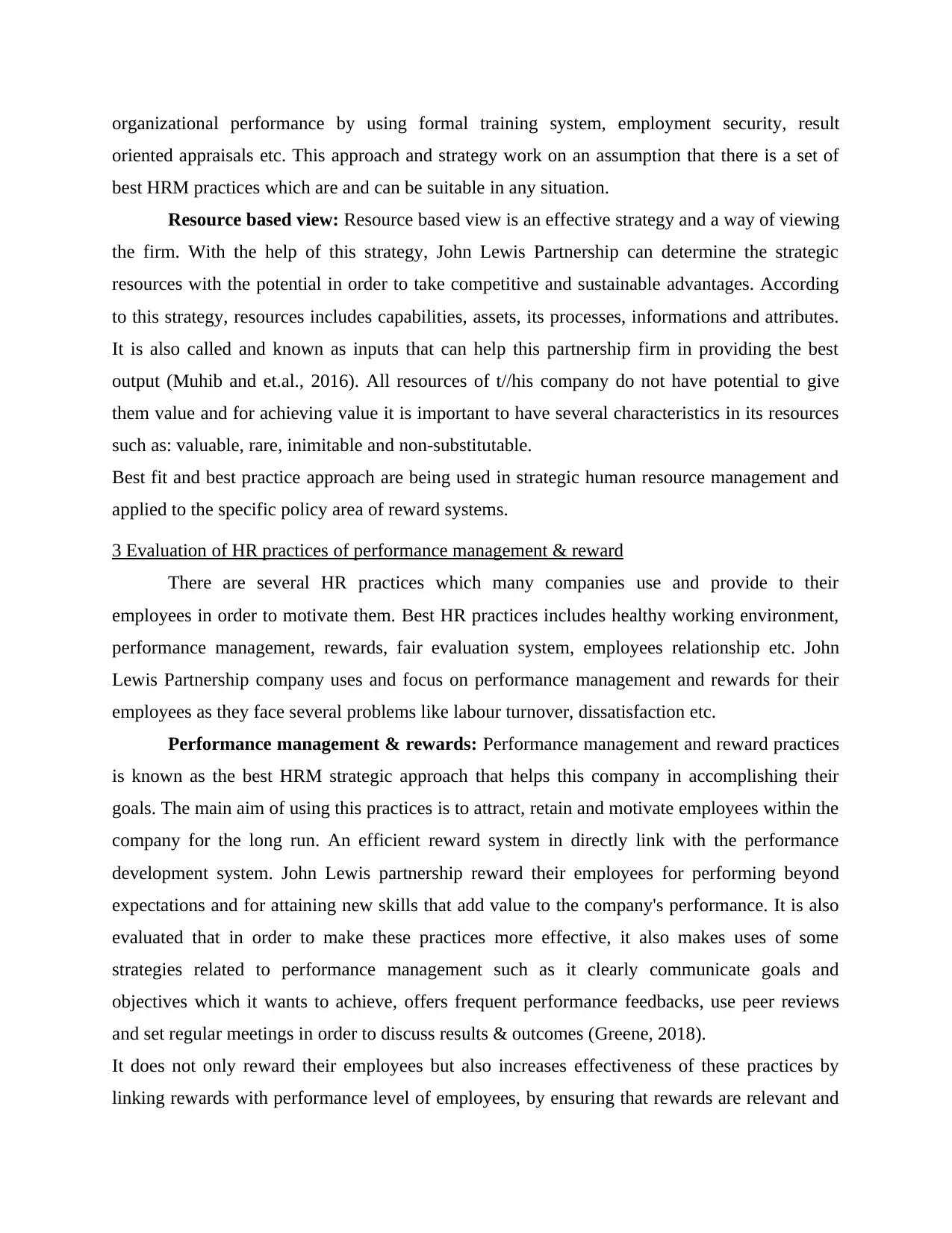
organizational performance by using formal training system, employment security, result
oriented appraisals etc. This approach and strategy work on an assumption that there is a set of
best HRM practices which are and can be suitable in any situation.
Resource based view: Resource based view is an effective strategy and a way of viewing
the firm. With the help of this strategy, John Lewis Partnership can determine the strategic
resources with the potential in order to take competitive and sustainable advantages. According
to this strategy, resources includes capabilities, assets, its processes, informations and attributes.
It is also called and known as inputs that can help this partnership firm in providing the best
output (Muhib and et.al., 2016). All resources of t//his company do not have potential to give
them value and for achieving value it is important to have several characteristics in its resources
such as: valuable, rare, inimitable and non-substitutable.
Best fit and best practice approach are being used in strategic human resource management and
applied to the specific policy area of reward systems.
3 Evaluation of HR practices of performance management & reward
There are several HR practices which many companies use and provide to their
employees in order to motivate them. Best HR practices includes healthy working environment,
performance management, rewards, fair evaluation system, employees relationship etc. John
Lewis Partnership company uses and focus on performance management and rewards for their
employees as they face several problems like labour turnover, dissatisfaction etc.
Performance management & rewards: Performance management and reward practices
is known as the best HRM strategic approach that helps this company in accomplishing their
goals. The main aim of using this practices is to attract, retain and motivate employees within the
company for the long run. An efficient reward system in directly link with the performance
development system. John Lewis partnership reward their employees for performing beyond
expectations and for attaining new skills that add value to the company's performance. It is also
evaluated that in order to make these practices more effective, it also makes uses of some
strategies related to performance management such as it clearly communicate goals and
objectives which it wants to achieve, offers frequent performance feedbacks, use peer reviews
and set regular meetings in order to discuss results & outcomes (Greene, 2018).
It does not only reward their employees but also increases effectiveness of these practices by
linking rewards with performance level of employees, by ensuring that rewards are relevant and
oriented appraisals etc. This approach and strategy work on an assumption that there is a set of
best HRM practices which are and can be suitable in any situation.
Resource based view: Resource based view is an effective strategy and a way of viewing
the firm. With the help of this strategy, John Lewis Partnership can determine the strategic
resources with the potential in order to take competitive and sustainable advantages. According
to this strategy, resources includes capabilities, assets, its processes, informations and attributes.
It is also called and known as inputs that can help this partnership firm in providing the best
output (Muhib and et.al., 2016). All resources of t//his company do not have potential to give
them value and for achieving value it is important to have several characteristics in its resources
such as: valuable, rare, inimitable and non-substitutable.
Best fit and best practice approach are being used in strategic human resource management and
applied to the specific policy area of reward systems.
3 Evaluation of HR practices of performance management & reward
There are several HR practices which many companies use and provide to their
employees in order to motivate them. Best HR practices includes healthy working environment,
performance management, rewards, fair evaluation system, employees relationship etc. John
Lewis Partnership company uses and focus on performance management and rewards for their
employees as they face several problems like labour turnover, dissatisfaction etc.
Performance management & rewards: Performance management and reward practices
is known as the best HRM strategic approach that helps this company in accomplishing their
goals. The main aim of using this practices is to attract, retain and motivate employees within the
company for the long run. An efficient reward system in directly link with the performance
development system. John Lewis partnership reward their employees for performing beyond
expectations and for attaining new skills that add value to the company's performance. It is also
evaluated that in order to make these practices more effective, it also makes uses of some
strategies related to performance management such as it clearly communicate goals and
objectives which it wants to achieve, offers frequent performance feedbacks, use peer reviews
and set regular meetings in order to discuss results & outcomes (Greene, 2018).
It does not only reward their employees but also increases effectiveness of these practices by
linking rewards with performance level of employees, by ensuring that rewards are relevant and
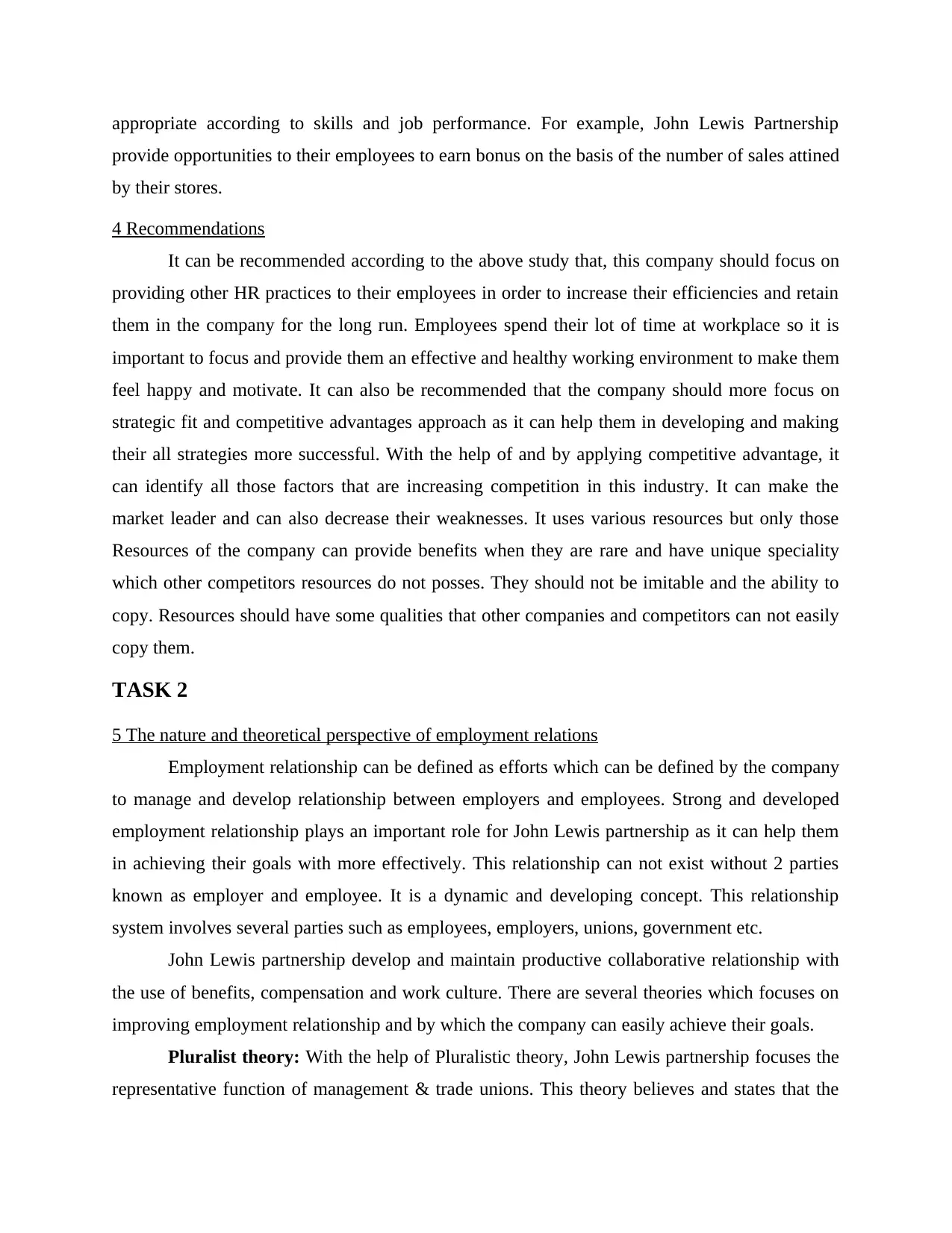
appropriate according to skills and job performance. For example, John Lewis Partnership
provide opportunities to their employees to earn bonus on the basis of the number of sales attined
by their stores.
4 Recommendations
It can be recommended according to the above study that, this company should focus on
providing other HR practices to their employees in order to increase their efficiencies and retain
them in the company for the long run. Employees spend their lot of time at workplace so it is
important to focus and provide them an effective and healthy working environment to make them
feel happy and motivate. It can also be recommended that the company should more focus on
strategic fit and competitive advantages approach as it can help them in developing and making
their all strategies more successful. With the help of and by applying competitive advantage, it
can identify all those factors that are increasing competition in this industry. It can make the
market leader and can also decrease their weaknesses. It uses various resources but only those
Resources of the company can provide benefits when they are rare and have unique speciality
which other competitors resources do not posses. They should not be imitable and the ability to
copy. Resources should have some qualities that other companies and competitors can not easily
copy them.
TASK 2
5 The nature and theoretical perspective of employment relations
Employment relationship can be defined as efforts which can be defined by the company
to manage and develop relationship between employers and employees. Strong and developed
employment relationship plays an important role for John Lewis partnership as it can help them
in achieving their goals with more effectively. This relationship can not exist without 2 parties
known as employer and employee. It is a dynamic and developing concept. This relationship
system involves several parties such as employees, employers, unions, government etc.
John Lewis partnership develop and maintain productive collaborative relationship with
the use of benefits, compensation and work culture. There are several theories which focuses on
improving employment relationship and by which the company can easily achieve their goals.
Pluralist theory: With the help of Pluralistic theory, John Lewis partnership focuses the
representative function of management & trade unions. This theory believes and states that the
provide opportunities to their employees to earn bonus on the basis of the number of sales attined
by their stores.
4 Recommendations
It can be recommended according to the above study that, this company should focus on
providing other HR practices to their employees in order to increase their efficiencies and retain
them in the company for the long run. Employees spend their lot of time at workplace so it is
important to focus and provide them an effective and healthy working environment to make them
feel happy and motivate. It can also be recommended that the company should more focus on
strategic fit and competitive advantages approach as it can help them in developing and making
their all strategies more successful. With the help of and by applying competitive advantage, it
can identify all those factors that are increasing competition in this industry. It can make the
market leader and can also decrease their weaknesses. It uses various resources but only those
Resources of the company can provide benefits when they are rare and have unique speciality
which other competitors resources do not posses. They should not be imitable and the ability to
copy. Resources should have some qualities that other companies and competitors can not easily
copy them.
TASK 2
5 The nature and theoretical perspective of employment relations
Employment relationship can be defined as efforts which can be defined by the company
to manage and develop relationship between employers and employees. Strong and developed
employment relationship plays an important role for John Lewis partnership as it can help them
in achieving their goals with more effectively. This relationship can not exist without 2 parties
known as employer and employee. It is a dynamic and developing concept. This relationship
system involves several parties such as employees, employers, unions, government etc.
John Lewis partnership develop and maintain productive collaborative relationship with
the use of benefits, compensation and work culture. There are several theories which focuses on
improving employment relationship and by which the company can easily achieve their goals.
Pluralist theory: With the help of Pluralistic theory, John Lewis partnership focuses the
representative function of management & trade unions. This theory believes and states that the
⊘ This is a preview!⊘
Do you want full access?
Subscribe today to unlock all pages.

Trusted by 1+ million students worldwide
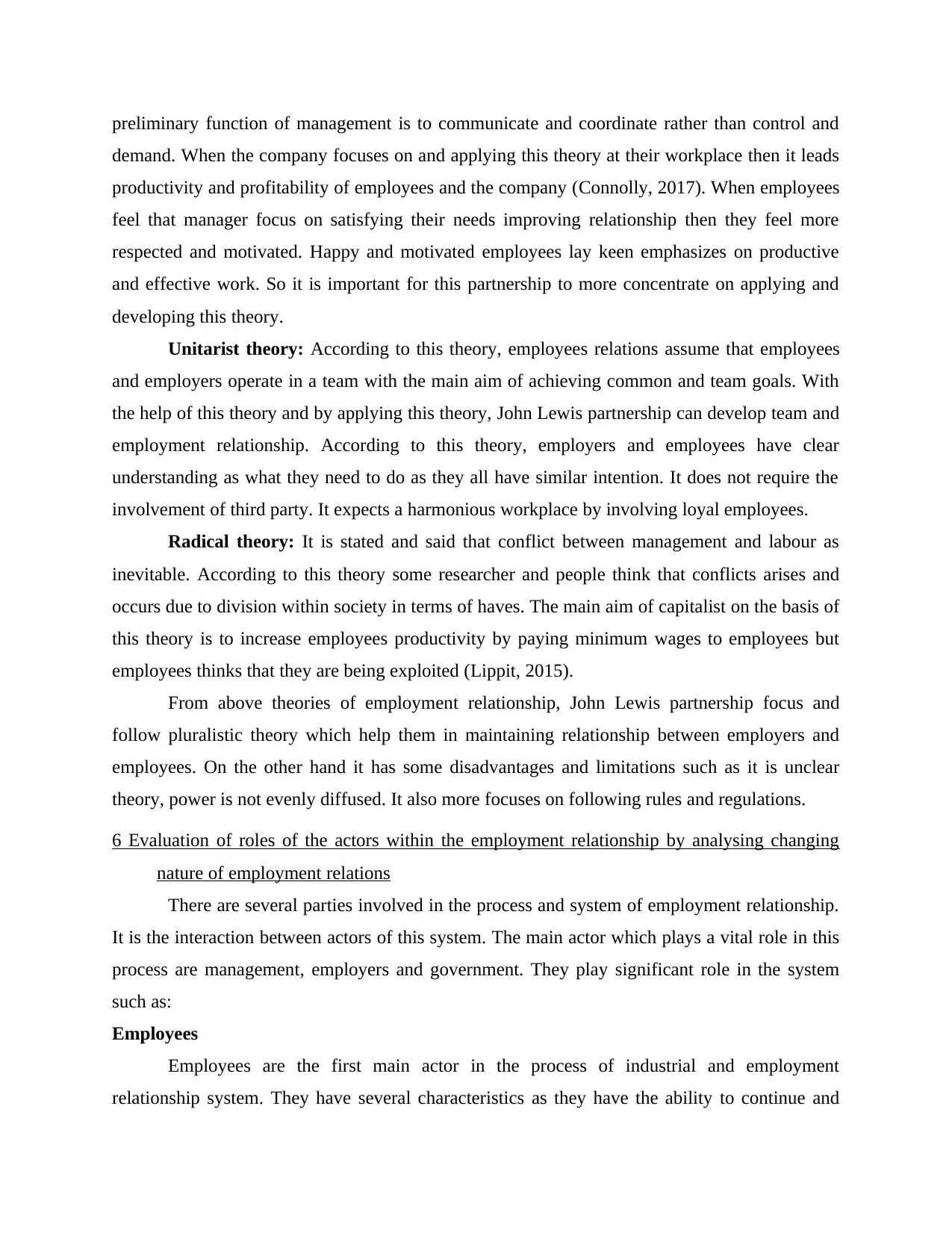
preliminary function of management is to communicate and coordinate rather than control and
demand. When the company focuses on and applying this theory at their workplace then it leads
productivity and profitability of employees and the company (Connolly, 2017). When employees
feel that manager focus on satisfying their needs improving relationship then they feel more
respected and motivated. Happy and motivated employees lay keen emphasizes on productive
and effective work. So it is important for this partnership to more concentrate on applying and
developing this theory.
Unitarist theory: According to this theory, employees relations assume that employees
and employers operate in a team with the main aim of achieving common and team goals. With
the help of this theory and by applying this theory, John Lewis partnership can develop team and
employment relationship. According to this theory, employers and employees have clear
understanding as what they need to do as they all have similar intention. It does not require the
involvement of third party. It expects a harmonious workplace by involving loyal employees.
Radical theory: It is stated and said that conflict between management and labour as
inevitable. According to this theory some researcher and people think that conflicts arises and
occurs due to division within society in terms of haves. The main aim of capitalist on the basis of
this theory is to increase employees productivity by paying minimum wages to employees but
employees thinks that they are being exploited (Lippit, 2015).
From above theories of employment relationship, John Lewis partnership focus and
follow pluralistic theory which help them in maintaining relationship between employers and
employees. On the other hand it has some disadvantages and limitations such as it is unclear
theory, power is not evenly diffused. It also more focuses on following rules and regulations.
6 Evaluation of roles of the actors within the employment relationship by analysing changing
nature of employment relations
There are several parties involved in the process and system of employment relationship.
It is the interaction between actors of this system. The main actor which plays a vital role in this
process are management, employers and government. They play significant role in the system
such as:
Employees
Employees are the first main actor in the process of industrial and employment
relationship system. They have several characteristics as they have the ability to continue and
demand. When the company focuses on and applying this theory at their workplace then it leads
productivity and profitability of employees and the company (Connolly, 2017). When employees
feel that manager focus on satisfying their needs improving relationship then they feel more
respected and motivated. Happy and motivated employees lay keen emphasizes on productive
and effective work. So it is important for this partnership to more concentrate on applying and
developing this theory.
Unitarist theory: According to this theory, employees relations assume that employees
and employers operate in a team with the main aim of achieving common and team goals. With
the help of this theory and by applying this theory, John Lewis partnership can develop team and
employment relationship. According to this theory, employers and employees have clear
understanding as what they need to do as they all have similar intention. It does not require the
involvement of third party. It expects a harmonious workplace by involving loyal employees.
Radical theory: It is stated and said that conflict between management and labour as
inevitable. According to this theory some researcher and people think that conflicts arises and
occurs due to division within society in terms of haves. The main aim of capitalist on the basis of
this theory is to increase employees productivity by paying minimum wages to employees but
employees thinks that they are being exploited (Lippit, 2015).
From above theories of employment relationship, John Lewis partnership focus and
follow pluralistic theory which help them in maintaining relationship between employers and
employees. On the other hand it has some disadvantages and limitations such as it is unclear
theory, power is not evenly diffused. It also more focuses on following rules and regulations.
6 Evaluation of roles of the actors within the employment relationship by analysing changing
nature of employment relations
There are several parties involved in the process and system of employment relationship.
It is the interaction between actors of this system. The main actor which plays a vital role in this
process are management, employers and government. They play significant role in the system
such as:
Employees
Employees are the first main actor in the process of industrial and employment
relationship system. They have several characteristics as they have the ability to continue and
Paraphrase This Document
Need a fresh take? Get an instant paraphrase of this document with our AI Paraphraser
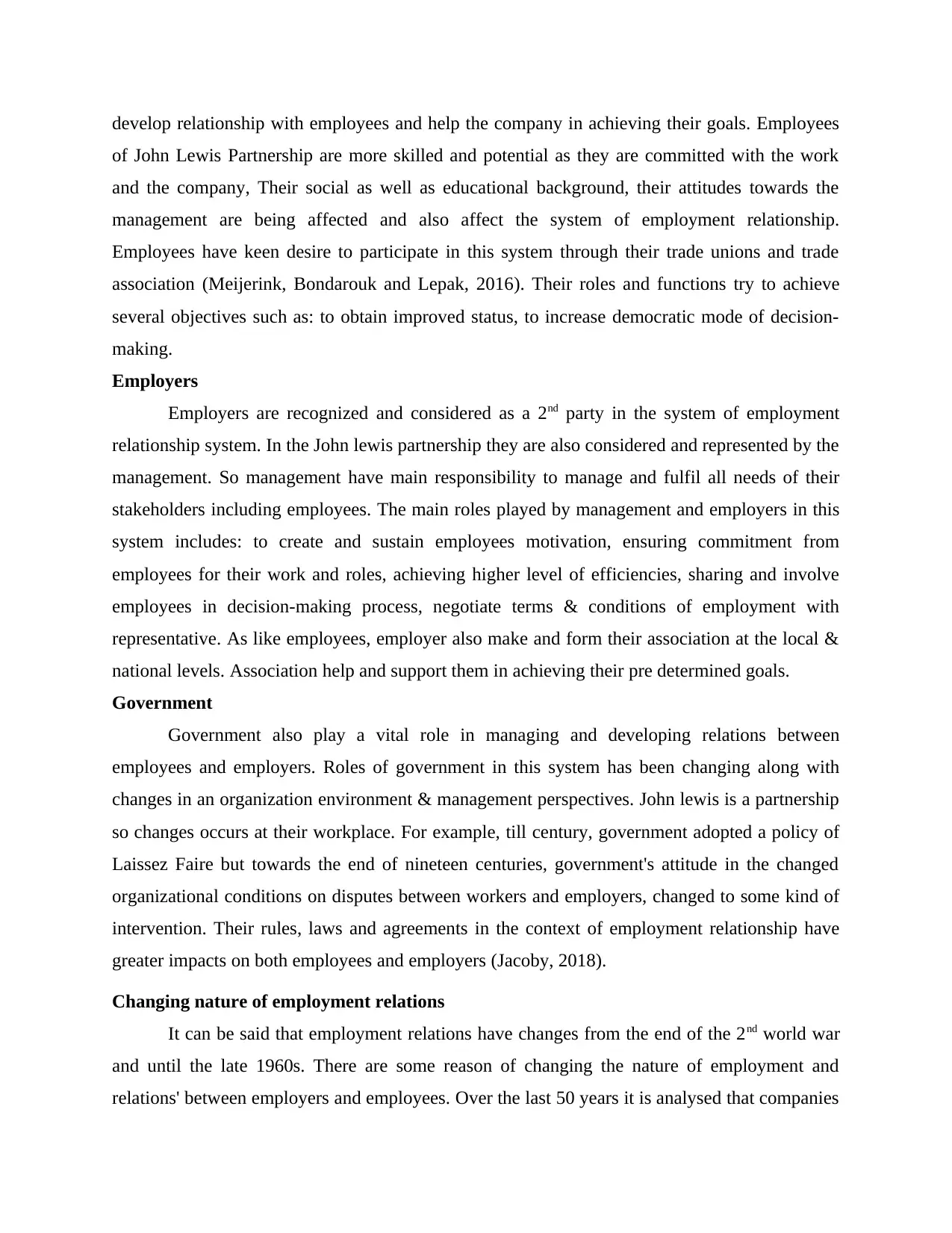
develop relationship with employees and help the company in achieving their goals. Employees
of John Lewis Partnership are more skilled and potential as they are committed with the work
and the company, Their social as well as educational background, their attitudes towards the
management are being affected and also affect the system of employment relationship.
Employees have keen desire to participate in this system through their trade unions and trade
association (Meijerink, Bondarouk and Lepak, 2016). Their roles and functions try to achieve
several objectives such as: to obtain improved status, to increase democratic mode of decision-
making.
Employers
Employers are recognized and considered as a 2nd party in the system of employment
relationship system. In the John lewis partnership they are also considered and represented by the
management. So management have main responsibility to manage and fulfil all needs of their
stakeholders including employees. The main roles played by management and employers in this
system includes: to create and sustain employees motivation, ensuring commitment from
employees for their work and roles, achieving higher level of efficiencies, sharing and involve
employees in decision-making process, negotiate terms & conditions of employment with
representative. As like employees, employer also make and form their association at the local &
national levels. Association help and support them in achieving their pre determined goals.
Government
Government also play a vital role in managing and developing relations between
employees and employers. Roles of government in this system has been changing along with
changes in an organization environment & management perspectives. John lewis is a partnership
so changes occurs at their workplace. For example, till century, government adopted a policy of
Laissez Faire but towards the end of nineteen centuries, government's attitude in the changed
organizational conditions on disputes between workers and employers, changed to some kind of
intervention. Their rules, laws and agreements in the context of employment relationship have
greater impacts on both employees and employers (Jacoby, 2018).
Changing nature of employment relations
It can be said that employment relations have changes from the end of the 2nd world war
and until the late 1960s. There are some reason of changing the nature of employment and
relations' between employers and employees. Over the last 50 years it is analysed that companies
of John Lewis Partnership are more skilled and potential as they are committed with the work
and the company, Their social as well as educational background, their attitudes towards the
management are being affected and also affect the system of employment relationship.
Employees have keen desire to participate in this system through their trade unions and trade
association (Meijerink, Bondarouk and Lepak, 2016). Their roles and functions try to achieve
several objectives such as: to obtain improved status, to increase democratic mode of decision-
making.
Employers
Employers are recognized and considered as a 2nd party in the system of employment
relationship system. In the John lewis partnership they are also considered and represented by the
management. So management have main responsibility to manage and fulfil all needs of their
stakeholders including employees. The main roles played by management and employers in this
system includes: to create and sustain employees motivation, ensuring commitment from
employees for their work and roles, achieving higher level of efficiencies, sharing and involve
employees in decision-making process, negotiate terms & conditions of employment with
representative. As like employees, employer also make and form their association at the local &
national levels. Association help and support them in achieving their pre determined goals.
Government
Government also play a vital role in managing and developing relations between
employees and employers. Roles of government in this system has been changing along with
changes in an organization environment & management perspectives. John lewis is a partnership
so changes occurs at their workplace. For example, till century, government adopted a policy of
Laissez Faire but towards the end of nineteen centuries, government's attitude in the changed
organizational conditions on disputes between workers and employers, changed to some kind of
intervention. Their rules, laws and agreements in the context of employment relationship have
greater impacts on both employees and employers (Jacoby, 2018).
Changing nature of employment relations
It can be said that employment relations have changes from the end of the 2nd world war
and until the late 1960s. There are some reason of changing the nature of employment and
relations' between employers and employees. Over the last 50 years it is analysed that companies
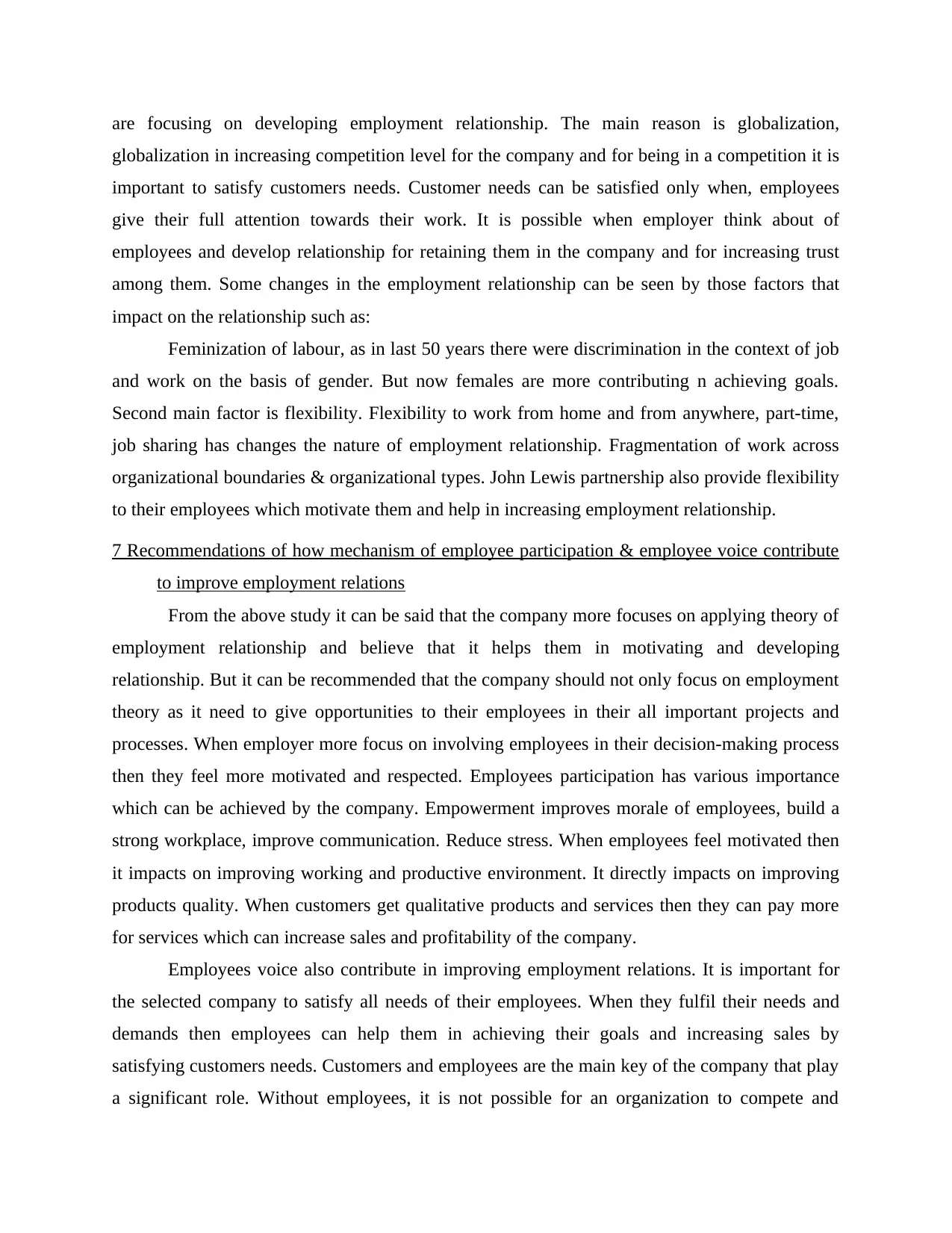
are focusing on developing employment relationship. The main reason is globalization,
globalization in increasing competition level for the company and for being in a competition it is
important to satisfy customers needs. Customer needs can be satisfied only when, employees
give their full attention towards their work. It is possible when employer think about of
employees and develop relationship for retaining them in the company and for increasing trust
among them. Some changes in the employment relationship can be seen by those factors that
impact on the relationship such as:
Feminization of labour, as in last 50 years there were discrimination in the context of job
and work on the basis of gender. But now females are more contributing n achieving goals.
Second main factor is flexibility. Flexibility to work from home and from anywhere, part-time,
job sharing has changes the nature of employment relationship. Fragmentation of work across
organizational boundaries & organizational types. John Lewis partnership also provide flexibility
to their employees which motivate them and help in increasing employment relationship.
7 Recommendations of how mechanism of employee participation & employee voice contribute
to improve employment relations
From the above study it can be said that the company more focuses on applying theory of
employment relationship and believe that it helps them in motivating and developing
relationship. But it can be recommended that the company should not only focus on employment
theory as it need to give opportunities to their employees in their all important projects and
processes. When employer more focus on involving employees in their decision-making process
then they feel more motivated and respected. Employees participation has various importance
which can be achieved by the company. Empowerment improves morale of employees, build a
strong workplace, improve communication. Reduce stress. When employees feel motivated then
it impacts on improving working and productive environment. It directly impacts on improving
products quality. When customers get qualitative products and services then they can pay more
for services which can increase sales and profitability of the company.
Employees voice also contribute in improving employment relations. It is important for
the selected company to satisfy all needs of their employees. When they fulfil their needs and
demands then employees can help them in achieving their goals and increasing sales by
satisfying customers needs. Customers and employees are the main key of the company that play
a significant role. Without employees, it is not possible for an organization to compete and
globalization in increasing competition level for the company and for being in a competition it is
important to satisfy customers needs. Customer needs can be satisfied only when, employees
give their full attention towards their work. It is possible when employer think about of
employees and develop relationship for retaining them in the company and for increasing trust
among them. Some changes in the employment relationship can be seen by those factors that
impact on the relationship such as:
Feminization of labour, as in last 50 years there were discrimination in the context of job
and work on the basis of gender. But now females are more contributing n achieving goals.
Second main factor is flexibility. Flexibility to work from home and from anywhere, part-time,
job sharing has changes the nature of employment relationship. Fragmentation of work across
organizational boundaries & organizational types. John Lewis partnership also provide flexibility
to their employees which motivate them and help in increasing employment relationship.
7 Recommendations of how mechanism of employee participation & employee voice contribute
to improve employment relations
From the above study it can be said that the company more focuses on applying theory of
employment relationship and believe that it helps them in motivating and developing
relationship. But it can be recommended that the company should not only focus on employment
theory as it need to give opportunities to their employees in their all important projects and
processes. When employer more focus on involving employees in their decision-making process
then they feel more motivated and respected. Employees participation has various importance
which can be achieved by the company. Empowerment improves morale of employees, build a
strong workplace, improve communication. Reduce stress. When employees feel motivated then
it impacts on improving working and productive environment. It directly impacts on improving
products quality. When customers get qualitative products and services then they can pay more
for services which can increase sales and profitability of the company.
Employees voice also contribute in improving employment relations. It is important for
the selected company to satisfy all needs of their employees. When they fulfil their needs and
demands then employees can help them in achieving their goals and increasing sales by
satisfying customers needs. Customers and employees are the main key of the company that play
a significant role. Without employees, it is not possible for an organization to compete and
⊘ This is a preview!⊘
Do you want full access?
Subscribe today to unlock all pages.

Trusted by 1+ million students worldwide
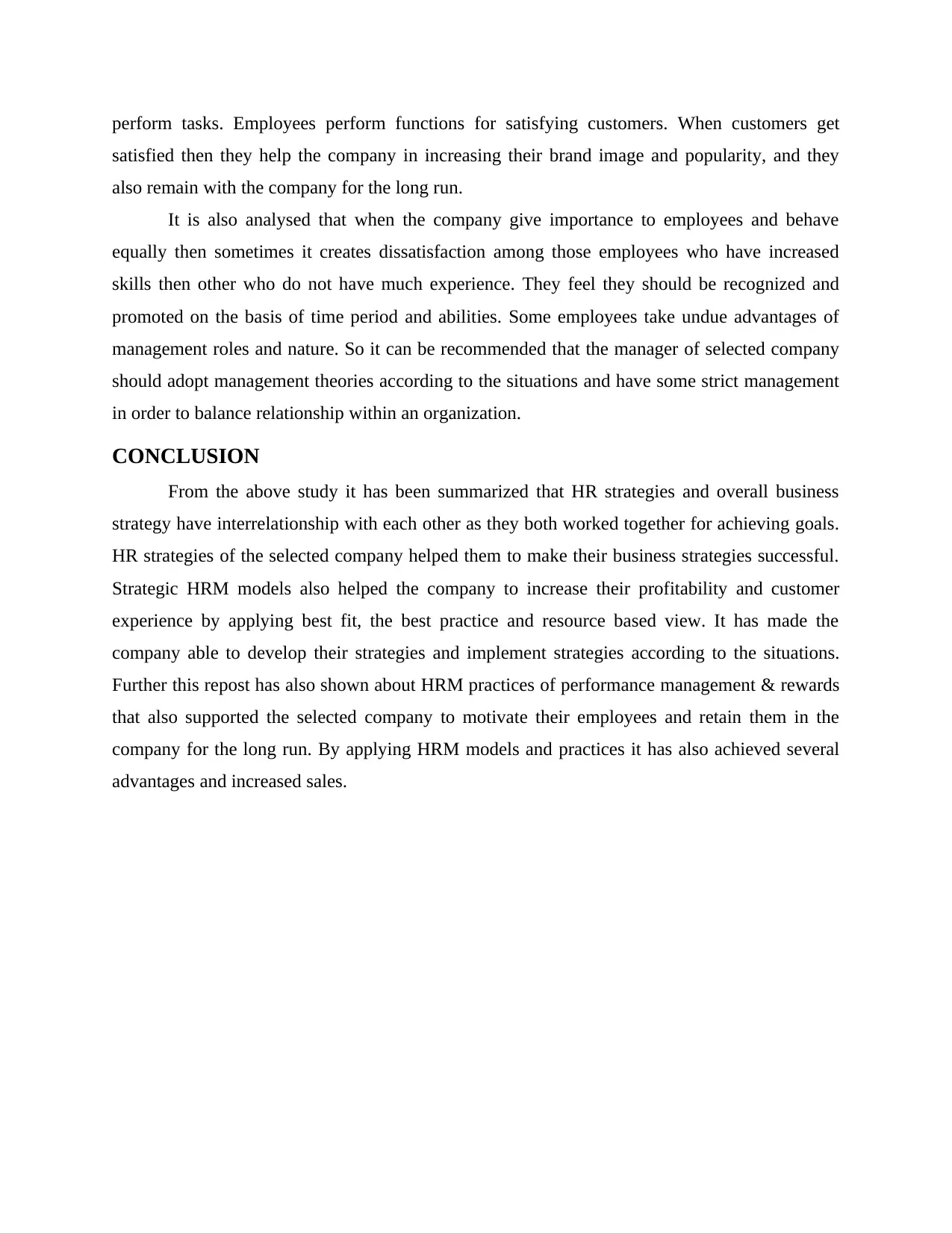
perform tasks. Employees perform functions for satisfying customers. When customers get
satisfied then they help the company in increasing their brand image and popularity, and they
also remain with the company for the long run.
It is also analysed that when the company give importance to employees and behave
equally then sometimes it creates dissatisfaction among those employees who have increased
skills then other who do not have much experience. They feel they should be recognized and
promoted on the basis of time period and abilities. Some employees take undue advantages of
management roles and nature. So it can be recommended that the manager of selected company
should adopt management theories according to the situations and have some strict management
in order to balance relationship within an organization.
CONCLUSION
From the above study it has been summarized that HR strategies and overall business
strategy have interrelationship with each other as they both worked together for achieving goals.
HR strategies of the selected company helped them to make their business strategies successful.
Strategic HRM models also helped the company to increase their profitability and customer
experience by applying best fit, the best practice and resource based view. It has made the
company able to develop their strategies and implement strategies according to the situations.
Further this repost has also shown about HRM practices of performance management & rewards
that also supported the selected company to motivate their employees and retain them in the
company for the long run. By applying HRM models and practices it has also achieved several
advantages and increased sales.
satisfied then they help the company in increasing their brand image and popularity, and they
also remain with the company for the long run.
It is also analysed that when the company give importance to employees and behave
equally then sometimes it creates dissatisfaction among those employees who have increased
skills then other who do not have much experience. They feel they should be recognized and
promoted on the basis of time period and abilities. Some employees take undue advantages of
management roles and nature. So it can be recommended that the manager of selected company
should adopt management theories according to the situations and have some strict management
in order to balance relationship within an organization.
CONCLUSION
From the above study it has been summarized that HR strategies and overall business
strategy have interrelationship with each other as they both worked together for achieving goals.
HR strategies of the selected company helped them to make their business strategies successful.
Strategic HRM models also helped the company to increase their profitability and customer
experience by applying best fit, the best practice and resource based view. It has made the
company able to develop their strategies and implement strategies according to the situations.
Further this repost has also shown about HRM practices of performance management & rewards
that also supported the selected company to motivate their employees and retain them in the
company for the long run. By applying HRM models and practices it has also achieved several
advantages and increased sales.
Paraphrase This Document
Need a fresh take? Get an instant paraphrase of this document with our AI Paraphraser
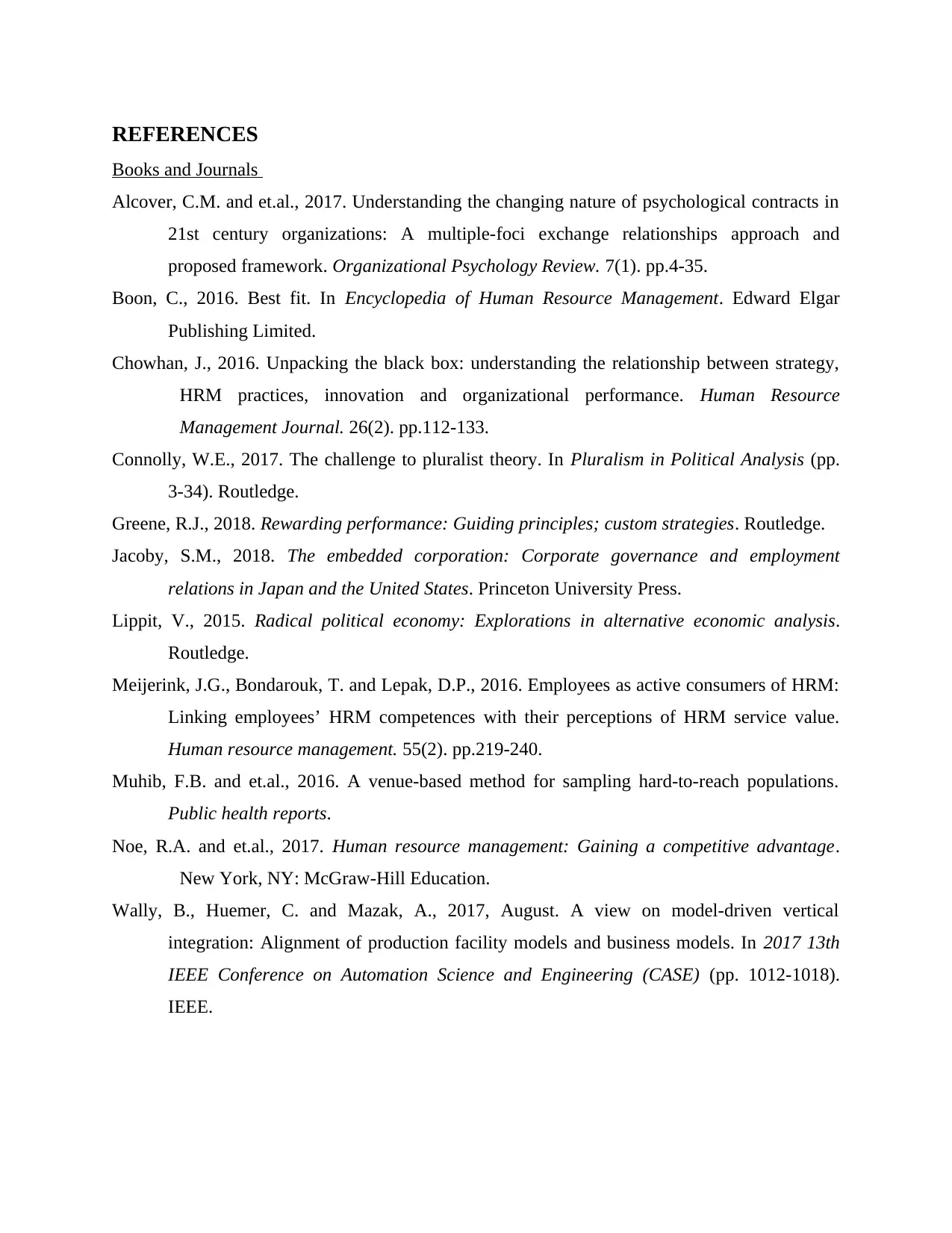
REFERENCES
Books and Journals
Alcover, C.M. and et.al., 2017. Understanding the changing nature of psychological contracts in
21st century organizations: A multiple-foci exchange relationships approach and
proposed framework. Organizational Psychology Review. 7(1). pp.4-35.
Boon, C., 2016. Best fit. In Encyclopedia of Human Resource Management. Edward Elgar
Publishing Limited.
Chowhan, J., 2016. Unpacking the black box: understanding the relationship between strategy,
HRM practices, innovation and organizational performance. Human Resource
Management Journal. 26(2). pp.112-133.
Connolly, W.E., 2017. The challenge to pluralist theory. In Pluralism in Political Analysis (pp.
3-34). Routledge.
Greene, R.J., 2018. Rewarding performance: Guiding principles; custom strategies. Routledge.
Jacoby, S.M., 2018. The embedded corporation: Corporate governance and employment
relations in Japan and the United States. Princeton University Press.
Lippit, V., 2015. Radical political economy: Explorations in alternative economic analysis.
Routledge.
Meijerink, J.G., Bondarouk, T. and Lepak, D.P., 2016. Employees as active consumers of HRM:
Linking employees’ HRM competences with their perceptions of HRM service value.
Human resource management. 55(2). pp.219-240.
Muhib, F.B. and et.al., 2016. A venue-based method for sampling hard-to-reach populations.
Public health reports.
Noe, R.A. and et.al., 2017. Human resource management: Gaining a competitive advantage.
New York, NY: McGraw-Hill Education.
Wally, B., Huemer, C. and Mazak, A., 2017, August. A view on model-driven vertical
integration: Alignment of production facility models and business models. In 2017 13th
IEEE Conference on Automation Science and Engineering (CASE) (pp. 1012-1018).
IEEE.
Books and Journals
Alcover, C.M. and et.al., 2017. Understanding the changing nature of psychological contracts in
21st century organizations: A multiple-foci exchange relationships approach and
proposed framework. Organizational Psychology Review. 7(1). pp.4-35.
Boon, C., 2016. Best fit. In Encyclopedia of Human Resource Management. Edward Elgar
Publishing Limited.
Chowhan, J., 2016. Unpacking the black box: understanding the relationship between strategy,
HRM practices, innovation and organizational performance. Human Resource
Management Journal. 26(2). pp.112-133.
Connolly, W.E., 2017. The challenge to pluralist theory. In Pluralism in Political Analysis (pp.
3-34). Routledge.
Greene, R.J., 2018. Rewarding performance: Guiding principles; custom strategies. Routledge.
Jacoby, S.M., 2018. The embedded corporation: Corporate governance and employment
relations in Japan and the United States. Princeton University Press.
Lippit, V., 2015. Radical political economy: Explorations in alternative economic analysis.
Routledge.
Meijerink, J.G., Bondarouk, T. and Lepak, D.P., 2016. Employees as active consumers of HRM:
Linking employees’ HRM competences with their perceptions of HRM service value.
Human resource management. 55(2). pp.219-240.
Muhib, F.B. and et.al., 2016. A venue-based method for sampling hard-to-reach populations.
Public health reports.
Noe, R.A. and et.al., 2017. Human resource management: Gaining a competitive advantage.
New York, NY: McGraw-Hill Education.
Wally, B., Huemer, C. and Mazak, A., 2017, August. A view on model-driven vertical
integration: Alignment of production facility models and business models. In 2017 13th
IEEE Conference on Automation Science and Engineering (CASE) (pp. 1012-1018).
IEEE.
1 out of 11
Related Documents
Your All-in-One AI-Powered Toolkit for Academic Success.
+13062052269
info@desklib.com
Available 24*7 on WhatsApp / Email
![[object Object]](/_next/static/media/star-bottom.7253800d.svg)
Unlock your academic potential
Copyright © 2020–2025 A2Z Services. All Rights Reserved. Developed and managed by ZUCOL.



